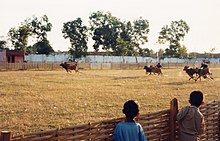Salt making in Madura in 1948
Subsistence agriculture is a mainstay of the economy. Maize is a key subsistence crop, on island's many small landholdings. Cattle-raising is also a critical part of the agricultural economy, providing extra income to peasant farmer families, in addition to being the basis for Madura's famous bull-racing competitions. Small-scale fishing is also important to the subsistence economy.
Among export industries, tobacco farming is a major contributor to the island's economy. Madura's soil, while unable to support many food crops, helps make the island an important producer of tobacco and cloves for the domestic kretek (clove cigarette) industry. Since the Dutch era, the island has also been a major producer and exporter of salt.
Bangkalan, on the western end of the island, has industrialized substantially since the 1980s. This region is within a short ferry ride of Surabaya, Indonesia's second-largest city, and hence has gained a role as a suburb for commuters to Surabaya, and as a location for industry and services that need to be near the city.
The Surabaya-Madura (Suramadu) Bridge, opened 2009, is expected to further increase the Bangkalan area's interaction with the regional economy.
[edit] Culture
[edit] Bull racing

Bull racing in Sumenep, Madura
[edit] Music and theater
Several forms of music and theater are popular on Madura, particularly among poorer people for whom they provide an inexpensive form of entertainment and community-building. The topeng theater, which involves masked performances of classical stories such as the Ramayana and Mahabharata, is the Madurese performance art best known outside the island, due to its role as a representative Madurese art form at exhibitions of regional cultures from all over Indonesia. However, performances of it are rare on Madura, and are generally restricted to entertainment at large official functions. The less formal loddrok theater, where performers do not wear masks and perform a wider range of themes, is more popular on the island.The gamelan orchestra, best known as a classical Javanese instrument, is also played on Madura, where several of the former royal courts, such as at Bangkalan and Sumenep, possess elaborate gamelans. Tongtong music, more exclusive to Madura, is played on several wooden or bamboo drums, and often accompanies bull-racing competitions.
[edit] Vessels
The Madurese used to be excellent sailors. Madurese vessels loaded with cargoes of wood from other islands, like Borneo, used to ply their trade between Indonesia and Singapore. Among the traditional vessels of Madura, the golekan and the leti-leti (or leteh-leteh), are worth mentioning.[1][edit] Notes
- ^ Clifford W. Hawkins, Praus of Indonesia ISBN 0333318102 / 0-333-31810-2
[edit] Further reading
- Bouvier, Hélène (1994) La matière des émotions. Les arts du temps et du spectacle dans la société madouraise (Indonésie). Publications de l'École Française d'Extrême-Orient, vol. 172. Paris : EFEO. ISBN 2-85539-772-3.
- Farjon, I.(1980) Madura and surrounding islands : an annotated bibliography, 1860-1942 The Hague: M. Nijhoff. Bibliographical series (Koninklijk Instituut voor Taal-, Land- en Volkenkunde (Netherlands)) ; 9.
- Kees van Dijk, Huub de Jonge, and Elly Touwen-Bouswsma, eds. (1995). Across Madura Strait: the dynamics of an insular society. Leiden: KITLV Press. ISBN 90-6718-091-2.
- Smith, Glenn (1995) Time Allocation Among the Madurese of Gedang-Gedang. Cross-Cultural Studies in Time Allocation, Volume XIII. New Haven, Connecticut: Human Relations Area Files Press.
- Smith, Glenn (2002) Bibliography of Madura (including Bawean, Sapudi and Kangean). [1]
[edit] External links
| Wikimedia Commons has media related to: Madura Island |

No comments:
Post a Comment